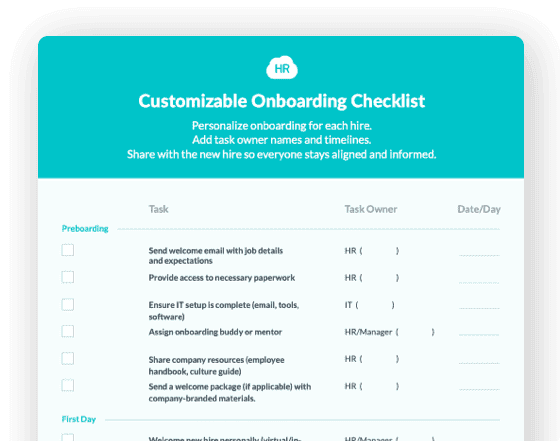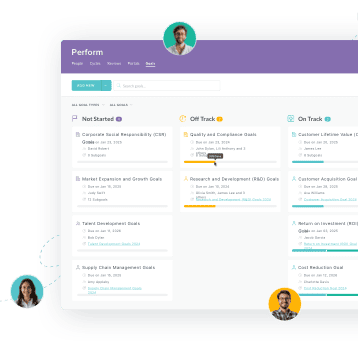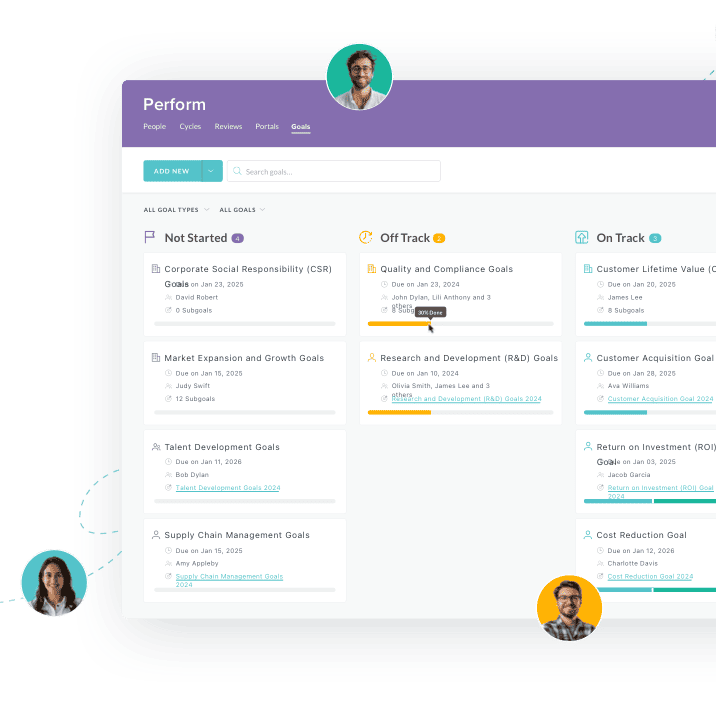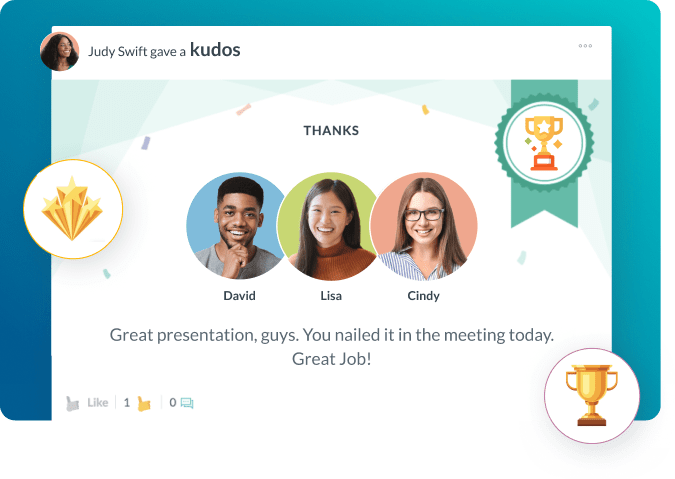Performance and Review: A Strategic Approach to Employee Development
- What Makes Performance Reviews Actually Work
- Framework: Shifting from Annual Reviews to Continuous Performance
- Practical Steps for Running Effective Performance Conversations
- Common Mistakes That Undermine Performance Systems
- How Different Industries Apply Performance Reviews
- Your Step-by-Step Implementation Blueprint
- The Evolution of Performance Management

 Cut onboarding time
by 60%—here's the
Ultimate Checklist
that helped do it.
Cut onboarding time
by 60%—here's the
Ultimate Checklist
that helped do it.

Performance and review systems form the foundation of how organizations measure, guide, and develop their workforce. At its core, a performance and review process is a structured method for evaluating employee contributions, providing meaningful feedback, and aligning individual efforts with organizational goals. This isn't just about annual meetings or rating scales. It's about creating a continuous conversation that helps employees understand where they excel, where they can improve, and how their work drives business success. When done right, performance management software transforms these interactions from dreaded encounters into powerful development opportunities that benefit everyone involved.
The modern workplace demands more from performance systems than ever before. Employees want regular feedback that helps them grow. Managers need practical tools to guide their teams effectively. Business leaders require data-driven insights to make strategic talent decisions. According to research from Deloitte, only 32% of executives believe their current approach enables timely, high-quality decisions about high and low performers. This gap between intention and execution creates real challenges for companies trying to build high-performing cultures. Performance and review systems that work address these challenges head-on, creating clarity, accountability, and momentum for both individual contributors and their organizations.
What Makes Performance Reviews Actually Work
Before diving into tactics, it's essential to understand what separates effective performance systems from those that waste everyone's time. Harvard Business Review research reveals that traditional annual reviews often emphasize holding employees accountable for past actions rather than improving current and future performance.
Performance reviews should drive development, not just document shortcomings. The best systems focus forward, helping employees build new skills and tackle bigger challenges.
Regular check-ins outperform annual reviews because they allow for real-time course corrections. Waiting 12 months to address performance issues means problems compound rather than resolve.
Two-way conversations create better outcomes than one-sided lectures. Employees need space to share their perspective, discuss obstacles they face, and contribute ideas for improvement.
Clear goals connected to business outcomes give performance discussions real meaning. When employees understand how their work matters, feedback becomes more relevant and actionable.
Specific, behavioral feedback works better than vague praise or criticism. Telling someone they "need to communicate better" helps no one. Pointing to specific examples and suggesting concrete improvements creates real change.
Multiple feedback sources provide a more complete picture. Peer input, self-assessments, and 360-degree reviews help identify blind spots that managers might miss.
Framework: Shifting from Annual Reviews to Continuous Performance
|
Traditional Annual Reviews |
Modern Continuous Performance |
|
One formal meeting per year |
Regular check-ins throughout the year |
|
Past-focused, accountability-driven |
Future-focused, development-oriented |
|
Manager-led monologue |
Collaborative dialogue between manager and employee |
|
Numerical ratings emphasize ranking |
Narrative feedback emphasizes growth |
|
Tied directly to compensation decisions |
Separates development from pay discussions |
|
Stressful, high-stakes event |
Natural, ongoing conversation |
|
Limited context, relies on recent memory |
Rich documentation of achievements over time |
|
Passive employee participation |
Active employee engagement in own development |
Practical Steps for Running Effective Performance Conversations
The difference between performance reviews that energize teams and those that drain morale often comes down to execution. Implementing thoughtful feedback practices requires preparation, skill, and genuine commitment to employee development.
Start by setting clear expectations upfront. Share the agenda ahead of time so employees can prepare thoughtfully. This simple step reduces anxiety and leads to more productive conversations. When both parties know what topics will be covered, they can gather examples, reflect on progress, and come ready to engage meaningfully.
Balance strengths with development areas in every discussion. Research shows that teams receiving feedback on their strengths demonstrate 12.5% higher productivity than those where reviews emphasize only weaknesses. Acknowledging what people do well isn't about sugar-coating problems. It's about building confidence and showing that you notice their contributions.
Make feedback specific and timely. Vague statements like "you need to improve your attitude" create confusion and defensiveness. Instead, reference specific situations, explain the impact, and suggest concrete alternatives. The closer feedback comes to the actual event, the more relevant and useful it becomes.
Encourage employee self-evaluations as part of your process. When employees reflect on their own performance before meeting with managers, they take ownership of their development. This self-awareness leads to more honest conversations and better outcomes.
Document conversations and agreed-upon action steps. Written records prevent misunderstandings and create accountability. They also provide valuable context for future discussions, helping you track progress over time.
Connect individual goals to team and organizational objectives. Employees need to see how their daily work contributes to bigger strategic priorities. This alignment gives performance discussions real purpose and helps everyone understand what success looks like.
Common Mistakes That Undermine Performance Systems
Even well-intentioned performance and review processes can fail when organizations fall into predictable traps. Understanding these pitfalls helps you avoid them.
Treating reviews as a once-yearly event represents the biggest mistake organizations make. Annual check-ins simply don't provide enough touchpoints for meaningful development. Problems that could be addressed quickly instead fester for months. Employees operate without clear direction, and by the time feedback arrives, it's too late to matter. According to SHRM research on modernizing reviews, 71% of companies still conduct performance reviews annually, despite evidence showing more frequent feedback drives better results.
Focusing exclusively on ratings rather than development conversations turns reviews into a numbers game. When employees fixate on whether they'll receive a three or a four on a rating scale, the actual feedback gets lost. The conversation becomes transactional instead of developmental.
Letting bias creep into evaluations damages trust and fairness. Recency bias causes managers to overweight recent events while forgetting earlier achievements. Similarity bias leads to favoring employees who remind managers of themselves. These unconscious patterns create inequitable outcomes that undermine the entire process.
Tying performance reviews too tightly to compensation discussions creates problems. When employees know their rating directly determines their raise, they become defensive about any critical feedback. Development conversations get hijacked by salary negotiations, preventing honest dialogue about growth opportunities.
Failing to follow through on commitments made during reviews signals that the process doesn't really matter. If managers promise training, mentorship, or support but never deliver, employees quickly learn that performance discussions are just empty ritual.


How Different Industries Apply Performance Reviews
Performance and review systems adapt to fit different work environments and business needs. Seeing how various sectors approach these challenges provides valuable perspective.
In healthcare, performance reviews focus heavily on clinical competencies, patient outcomes, and compliance with safety protocols. A hospital might evaluate nurses on bedside manner, medication error rates, and continuing education completion. Regular performance check-ins help identify training needs and ensure staff maintain certifications. Goal tracking tools help healthcare organizations monitor both individual development and department-wide quality metrics.
Technology companies often emphasize innovation, collaboration, and technical skill development in their performance systems. A software company might measure developers on code quality, project completion rates, and contributions to team knowledge sharing. Many tech firms have moved away from traditional annual reviews toward continuous feedback models that support agile work environments.
Manufacturing environments tie performance reviews to safety records, quality standards, and operational efficiency. A production supervisor might be evaluated on equipment downtime, defect rates, and team safety incidents. These concrete metrics combine with leadership behaviors to create a complete picture of performance.
Your Step-by-Step Implementation Blueprint
Transforming your performance and review approach requires thoughtful planning and systematic execution. This roadmap guides you through the process.
First, assess your current state honestly. Survey employees and managers about what works and what doesn't in your existing system. Analyze turnover data to identify whether performance dissatisfaction contributes to departures. Review the time and resources your current process consumes. This baseline helps you understand what needs to change.
Second, define clear objectives for your new approach. What outcomes do you want to achieve? Improved employee engagement? Better talent development? Stronger alignment with business goals? Building a comprehensive performance management strategy requires clarity about your destination.
Third, select the right tools and technology. Modern performance systems rely on platforms that facilitate regular check-ins, goal tracking, and documentation. Choose solutions that integrate with your other HR systems and make the process easier, not more complicated.
Fourth, train managers thoroughly. The best system design fails if managers lack the skills to execute it well. Invest in workshops that teach how to give effective feedback, conduct development conversations, and address performance issues directly.
Fifth, pilot your new approach with a small group before rolling out organization-wide. Test with one department or team, gather feedback, refine your process, and then expand. This iterative approach prevents costly mistakes and builds confidence.
Sixth, communicate the changes clearly to all employees. Explain why you're evolving your approach, what to expect, and how it benefits them. Transparency reduces resistance and helps everyone adapt more smoothly.
Seventh, monitor adoption and impact consistently. Track participation rates in check-ins, employee satisfaction with the process, and whether performance actually improves. Use this data to make ongoing refinements.
The Evolution of Performance Management
The future of performance and review systems looks dramatically different from past approaches. Understanding emerging trends helps you prepare your organization for what's coming.
Artificial intelligence is reshaping how organizations track and analyze performance data. AI-powered tools can identify patterns in feedback, flag potential bias, and suggest personalized development opportunities. According to Harvard Business Review research on performance review effectiveness, narrative feedback that provides context and personalized analysis creates fairer outcomes than numerical ratings alone.
Continuous feedback is becoming the standard rather than the exception. Organizations increasingly recognize that annual reviews don't match the pace of modern work. Real-time recognition, weekly check-ins, and ongoing coaching conversations replace formal once-yearly discussions. Implementing best practices for performance reviews means building systems that support frequent, informal feedback alongside structured conversations.
Skills-based performance tracking is gaining momentum as organizations shift from job-based to skills-based work models. Rather than evaluating whether someone performs well in a specific role, forward-thinking companies assess which capabilities employees are building and how those skills support strategic priorities.
Employee experience platforms are integrating performance management with other aspects of the work journey. Rather than treating reviews as standalone events, organizations embed feedback into daily workflows, recognition programs, and learning systems. This holistic approach makes performance development feel natural rather than forced.
Equity and fairness are receiving unprecedented attention. Organizations are examining their performance systems for bias and implementing safeguards to ensure fair treatment. Transparency in criteria, multiple feedback sources, and calibration sessions help create more equitable outcomes.
Preparing for these shifts means starting now to build the foundation for more dynamic, employee-centered performance systems. Organizations that embrace continuous feedback, leverage technology thoughtfully, and focus on genuine development will attract and retain the best talent. The future belongs to companies that see performance and review not as administrative burden but as strategic opportunity to unlock human potential and drive business results.
Keep Reading
The Hidden Metrics of Frontline Success: Beyond Engagement Scores
"What gets measured gets managed, but what gets measured well gets transformed." — Peter
Embracing Diversity: Recognizing Different Cultures in the Workplace
Workplaces today reflect the incredible diversity of the world around us. People bring
From Manual to Automated: A Complete Guide to Digitizing Employee Onboarding for Large Organizations
Sarah Chen, Director of HR at a 7,000-employee healthcare organization, starts her Monday
Ready to streamline your onboarding process?
Book a demo today and see how HR Cloud can help you create an exceptional experience for your new employees.







